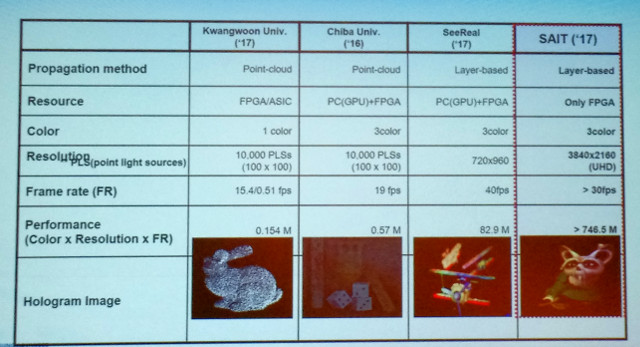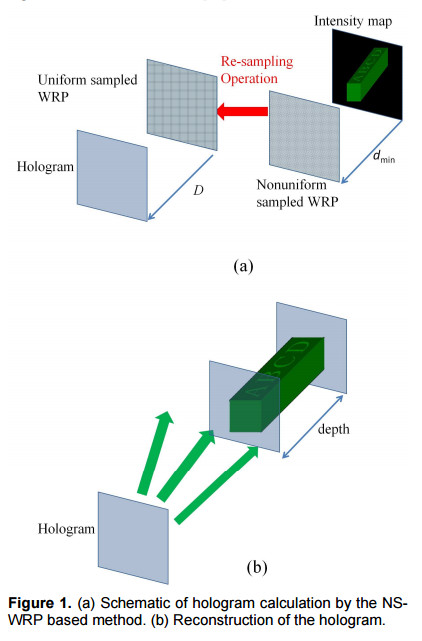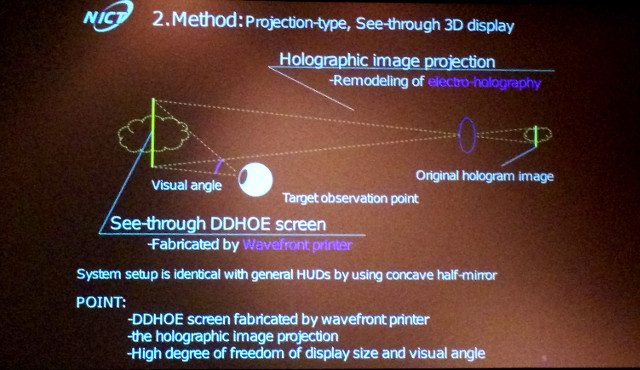Session 54 was called “Holographic” and was a catchall for some related papers. In the first paper, Kai-Han Chang from Kent State University talked about a novel way to reduce speckle in laser illumination. The idea is to embed particles in the liquid crystal material. This use was actually accidentally discovered as the embedded particles were being developed for digital signage displays.
Chang’s paper described modeling his group has done that allows various properties like particle size and medium refractive index and other parameters to be changed and analyzed as a function of wavelength. Experimentally, two materials were evaluated and their scattering properties compared, as shown below. No studies have been done yet to understand the effect on image quality, however.

Hong-Seok Lee and others from the Device Lab of Samsung Advanced Research Institute in Korea started by noting that the viewing (diffraction) angle of a classical hologram is limited by the pixel pitch of the display or spatial light modulator. A smartphone with 432 ppi can only create a viewing cone of 0.5 degrees. To get to a 180º viewing cone, you need 100K ppi, which is not obtainable today, of course. However, his talk discussed a possible display solution with 25,400 ppi with 1 micron-sized pixels which could enable a viewing cone of 30 degrees.
Their idea is to introduce a steerable backlight field that is used to direct light through a spatial light modulator only to a fixed position in the viewer space. Only the holographic element and light rays that need to go to each eye are calculated and relayed to the spatial light modulator, significantly reducing computational load. This seems to be very similar to the approach developed by SeeReal. The steerable backlight features an input and output grating fabricated with a nanoimprinting technique.
System parameters are summarized below. This appears to be a horizontal parallax only solution as the head position is limited. In comments after the presentation, he said that they will be more focused going forward on a flat panel solution for AR/VR with the goal of having a prototype ready by 2020.
The chart below shows a comparison of some of the computation and performance features of their system. Note the significant improvement in resolution and performance. We are unclear if this was shown in the Samsung booth in the darkened room as we were never able to visit that area.

The third talk from Chenliang Chang of Nanjing Normal University focused on reducing the computational load for computer generated holograms (CGH) since most methods require complex calculations and enormous storage. As a result, real time generation can be difficult.
Chang described some of the approaches used for CGH such as the point-based method with look-up tables, the layer-based approach and polygon meshes – and some of their deficiencies. Another method is called wavefront recording plane (WRP). Here, a virtual 2D WRP that is close to the object scene is derived. For each object point, only a small zone of diffraction fringe patterns is determined. Chang says this method dramatically reduces total computational complexity, but there may be a lot of points to calculate, so it is time consuming as well.
In his paper, Chang explained their non-uniform sampling method using Fourier transforms to reduce this computational complexity of the WRP approach. This allows a lensless holographic projection display solution as well.

The final paper from Koki Wakunami of the National Institute of Information and Communication Technology (NICT) in Japan described a projection-type holographic display. The system is shown below.

First, a holographic image is created using their existing system, which features an 8K spatial light modulator. The team then designed a new Digitally Designed Holographic Optical Element DDHOE) to act as the screen in combination with a magnifying lens. The resulting display image size was 75 x 41 mm (twice the size of the original holographic image) and was viewed from an angle of 20.8º (6 times larger than original). NICT thinks this design can help accelerate the use of holography in HUDs, AR and VR. Future work will focus on developing a full color solution. – CC

